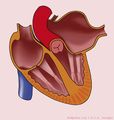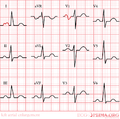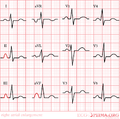Chamber Hypertrophy and Enlargment: Difference between revisions
| Line 27: | Line 27: | ||
This is a better predicting criterium than the Sokolow-Lyon criterium, but less easy to remember, and therefore less often used.<cite>Levy</cite><cite>Sundstrom</cite> | This is a better predicting criterium than the Sokolow-Lyon criterium, but less easy to remember, and therefore less often used.<cite>Levy</cite><cite>Sundstrom</cite> | ||
In the | In the [[Romhilt-Estes Score]] LVH is ''likely'' with 4 or more points. LVH is ''present'' with 5 or more points: | ||
Romhilt-Estes point score system ("diagnostic" >5 points; "probable" 4 points):<cite>Romhilt</cite> | Romhilt-Estes point score system ("diagnostic" >5 points; "probable" 4 points):<cite>Romhilt</cite> | ||
Romhilt has reviewed ECG LVH criteria and gives an overview of the many LVH scoring systems. <cite>Romhilt2</cite> Left ventricular hypertrophy has prognostic consequences as has been found in several studies.<cite>Levy</cite><cite>Sundstrom</cite> | Romhilt has reviewed ECG LVH criteria and gives an overview of the many LVH scoring systems. <cite>Romhilt2</cite> Left ventricular hypertrophy has prognostic consequences as has been found in several studies.<cite>Levy</cite><cite>Sundstrom</cite> | ||
Revision as of 21:01, 18 November 2011
| Author(s) | J.S.S.G. de Jong | |
| Moderator | J.S.S.G. de jong | |
| Supervisor | ||
| some notes about authorship | ||
In hypertrophy the heart muscle becomes thicker. This can have different causes. Left ventricular hypertrophy results from an increase in left ventricular workload, e.g., during hypertension or aortic valve stenosis. Right ventricular hypertrophy results from an increase in right ventricular workload, e.g., emphysema or pulmonary embolization. These causes are fundamentally different from hypertrophic obstructive cardiomyopathy (HCM), which is a congenital misalignment of cardiomyocytes, resulting in hypertrophy.
Left and right ventricular hypertrophy can be distinguished on the ECG:
Left ventricular hypertrophy
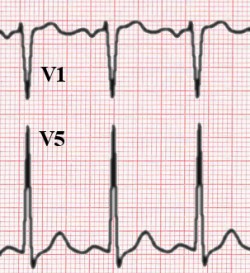
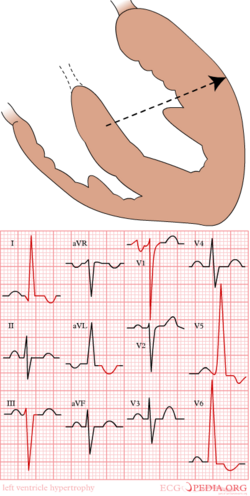
As the left ventricular wall becomes thicker, the QRS complexes become larger. This is especially true for leads V1-V6. The S wave in V1 is deep, the R wave in V4 is high. Often some ST depression can be seen in leads V5-V6, which is in this setting is called a 'strain pattern'.
To diagnose left ventricular hypertrhophy on the ECG one of the following criteria should be met: The Sokolow-Lyon criteriumSokolow), this is most often used:
- R in V5 or V6 + S in V1 >35 mm.
This criterium is not reliable below age 40 years.Chou In 10-29 year olds, the 99th percentile for SV1+RV5 is 53mm. In 20-39 year olds: 32% have SV2+RV5 > 35 mm.chou Correlation between LVH on ECG and echocardiography is low with ECG having a sensitivity of 27% and specicity of 88% for echocardiographically measured LVHechoecho2. Moreover, both are independent estimators of worse prognosis.sundstrom.
The Cornell-criterium has different values in men and women:
- R in aVL and S in V3 >28 mm in men
- R in aVL and S in V3 >20 mm in women
This is a better predicting criterium than the Sokolow-Lyon criterium, but less easy to remember, and therefore less often used.LevySundstrom
In the Romhilt-Estes Score LVH is likely with 4 or more points. LVH is present with 5 or more points: Romhilt-Estes point score system ("diagnostic" >5 points; "probable" 4 points):Romhilt
Romhilt has reviewed ECG LVH criteria and gives an overview of the many LVH scoring systems. Romhilt2 Left ventricular hypertrophy has prognostic consequences as has been found in several studies.LevySundstrom
Example
-
ECG of patient with left ventricular hypertrophy according to the Sokolow-Lyon criteria
-
Another example of extreme left ventricular hypertrophy in a patient with severe aortic valve stenosis.
-
ECG of a patient with LVH and subendocardial ischemia leading to positive cardiovascular markers in blood testing.
Right ventricular hypertrophy
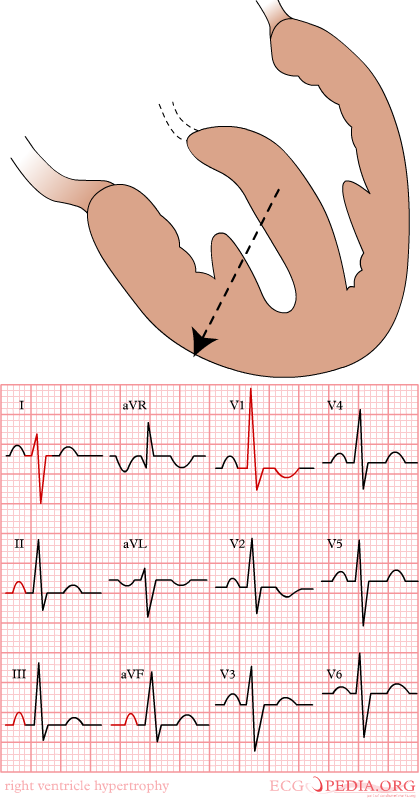


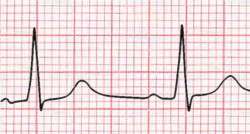
Right ventricular hypertrophy occurs mainly in lung disease or in congenital heart disease. The ECG shows a negative QRS complex in I (and thus a right heart axis) and a positive QRS complex in V1.
- QRS duration < 120ms
- Right heart axis (> 110 degrees)
- Dominant R wave:
- R/S ratio in V1 or V3R > 1, or R/S ratio in V5 or V6 <= 1
- R wave in V1 >= 7 mm
- R wave in V1 + S wave in V5 or V6 > 10.5 mm
- rSR= in V1 with R'= > 10 mm
- qR complex in V1
- Secondary ST-T changes in right precordial leads
- Right atrial abnormality
- Onset of intrinsicoid deflection in V1 between 0.035 and 0.055 s
Left atrial enlargement
-
Left atrial enlargement
-
Left atrial enlargement with ECG.
-
Left atrial enlargement as seen in lead V1.
-
Left atrial enlargement as seen on a 12 lead ECG
- Criteria for left atrial voor left atrial enlargement. Either
- P wave with a broad (>0.04 sec or 1 small square) and deeply negative (>1 mm) terminal part in V1
- P wave duration >0.12 sec in leads I and / or II
Left atrial enlargement is often seen in mitral valve insufficiency, resulting in back flow of blood from the left ventricle to the left atrium and subsequent increased local pressure.
Right atrial enlargement
- Right atrial enlargement is defined as either
- P >2.5 mm in II / III and / or aVF
- P >1.5 mm in V1.
Right atrial enlargement can result from increased pressure in the pulmonary artery, e.g. after pulmonary embolization. A positive part of the biphasic p-wave in lead V1 larger than the negative part indicates right atrial enlargement. The width of the p wave does not change.
Biatrial enlargement
- Biatrial enlargement
- Biphasic p wave in V1 of more than 0.04 sec duration. The positive initial part is > 1.5mm and the negative terminal part > 1mm
In biatrial enlargement the ECG shows signs of both left and right atrial enlargement. In V1 the p wave has large peaks first in a positive and later in a negative direction.
{{{1}}}



